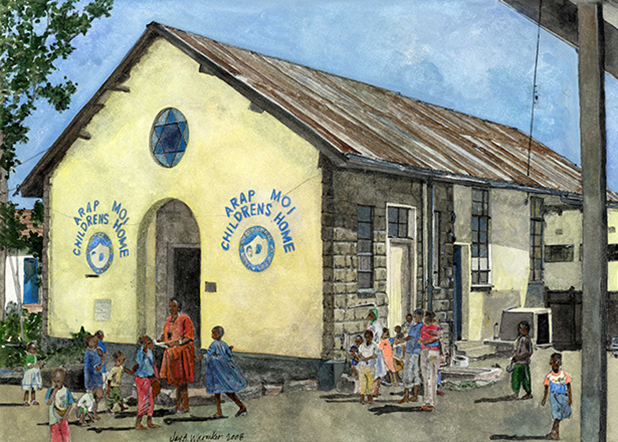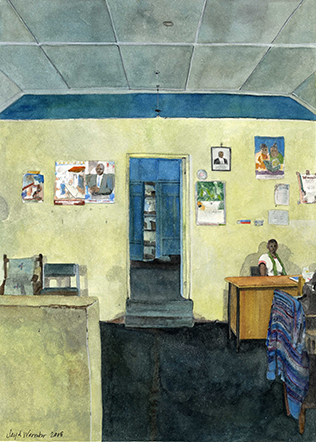 Exterior View (2012), 15” x 11” Watercolor, Jay A. Waronker
Exterior View (2012), 15” x 11” Watercolor, Jay A. Waronker
kenya
Former Synagogue (Congregation formed in 1940s; Synagogue Built in 1956) |
|

Interior View (2012), 11” x 15” Watercolor, Jay A. Waronker
|
Although Nairobi has always been home to most of Kenya’s Jews, other towns throughout the country also had small European Jewish communities formed as a result of immigration during World War II: in and around Nakuru, Kitale and adjacent Eldoret, Gilgil, as well as at Mombasa. Of the four, only Nakuru ever had a synagogue proper. In the other places, the Jews prayed in private homes, and they relied on the Nairobi Jewish community to loan them a Sefer Torah and other liturgical objects. As a consequence of the independence movement and socio-political changes in Kenya, by the early 1960s most of the Jews had left these areas. By the late 1960s, Jewish life had essentially ceased in these smaller cities and towns.
Nakuru, in central Kenya some 125 miles (two and a quarter hours driving time along a well-paved highway) to the northwest of Nairobi, became home to a relatively sizeable Jewish population by beginning of World War II. This community was made up of German Jews settling in the area that, due to war-time restrictions was prohibited from living in Nairobi. It was also comprised of South African Jewish soldiers stationed in and around Nakuru. Initially the Jews in the area held their Shabbat and holiday prayer services in the Freemasons Lodge, yet around 1941 a donation by Baron Rothschild’s daughter, who was farming in the area, allowed the congregation to purchase a plot of land with a wooden garage. This building was then converted into a rudimentary sanctuary. One soldier based in the area, the senior Jewish chaplain of the Union Forces by the name of Captain Menachemson, organized the first prayer service in Nakuru in this converted space in April 1941.
By 1947, the Nakuru synagogue had acquired its own hazan (cantor), Reverend F. Lichtenstein from Germany, who was a survivor of the Holocaust. Hazan Lichtenstein had led the first service in Berlin after the city had been liberated by the Russian army in 1945. For Nakuru’s congregation numbering some one hundred twenty people, a proper synagogue was built in the center of town near Government Road and West Road in 1956. It was built on a parcel of land to the west (left) side of the main road when arriving from Nairobi. The synagogue’s foundation stone was laid by the mayor of Nakuru, Councilor Gustav Kramer on April 29, 1956. This small, architectural modest building, featuring a mixture of stone and exterior plaster walls, large windows along its sides, gabled galvanized metal roof, and a blank façade except for a rounded-arch opening with a Star of David window above, served the community for a few decades until its decline.
By 1947, the Nakuru synagogue had acquired its own hazan (cantor), Reverend F. Lichtenstein from Germany, who was a survivor of the Holocaust. Hazan Lichtenstein had led the first service in Berlin after the city had been liberated by the Russian army in 1945. For Nakuru’s congregation numbering some one hundred twenty people, a proper synagogue was built in the center of town near Government Road and West Road in 1956. It was built on a parcel of land to the west (left) side of the main road when arriving from Nairobi. The synagogue’s foundation stone was laid by the mayor of Nakuru, Councilor Gustav Kramer on April 29, 1956. This small, architectural modest building, featuring a mixture of stone and exterior plaster walls, large windows along its sides, gabled galvanized metal roof, and a blank façade except for a rounded-arch opening with a Star of David window above, served the community for a few decades until its decline.
Along with the sanctuary building, the synagogue campus contained a social hall, educational building, and administrative space. After World War II, restrictions were lifted as to where Kenyan Jews could live, and many shifted to Nairobi. Others left the country at that point or some years later after Kenya gained its independence from Britain in 1963. By then, the Jewish population of Nakuru numbered less than twenty. With so few Jews left in the community, the synagogue was eventually sold. Proceeds were given to the Nairobi Hebrew Congregation on the condition that part of funds would be channeled to maintaining the Nakuru Jewish cemetery. Since 1971, the property has served as the Daniel Arap Moi Orphanage, named as the former president of Kenya, where children of various ages live and are schooled. Today visitors are welcome on the site made up in part of the original synagogue buildings that are adequately maintained.
Founded in 1941, the Jewish community of Nakuru for some years organized prayer services in private homes. It was not until 1956 that an actual synagogue was erected in the center of town. The small building features a foyer, an office off the foyer, and 25’ x 40’ x 14’ high (sloping to 12’ at the side walls) sanctuary. The sanctuary is lined by four large metal casement windows along each side of the space, and it features painted plaster walls and a concrete floor. Much of the original furniture of the sanctuary is no longer in place. The space served the Jewish community for only a few short years before most of its members elected to leave the country (or some moving to Nairobi) following national independence from Britain in 1963.
By the mid-1960s, Nakuru practically had no Jews, and the synagogue and property were eventually sold to become the Daniel Arap Moi Orphanage, named in honor of a president of Kenya. What was once the sanctuary space is today used for offices and a gathering spot, and the former Ark now functions as a storage cabinet for orphanage records and odd supplies. In some cases makeshift partitions walls have been installed along with other modest changes to the interior, yet the shell of space is otherwise intact an adequately maintained.
